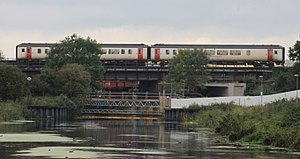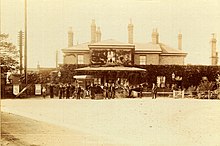
Leiston is a town and civil parish in the East Suffolk district of Suffolk, England. It is close to Saxmundham and Aldeburgh, 21 miles (34 km) north-east of Ipswich and 90 miles (145 km) north-east of London. The town had a population of 5,508 at the 2011 Census.

East Suffolk, along with West Suffolk, was created in 1888 as an administrative county of England. The administrative county was based on the eastern quarter sessions division of Suffolk. East Suffolk County Council's headquarters were at East Suffolk County Hall in Ipswich.
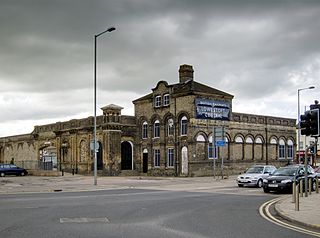
Lowestoft railway station serves the town of Lowestoft, Suffolk. It is the eastern terminus of the East Suffolk Line from Ipswich and is one of two eastern termini of the Wherry Lines from Norwich. Lowestoft is 23 miles 41 chains (37.8 km) down the line from Norwich and 48 miles 75 chains (78.8 km) measured from Ipswich; it is the easternmost station on the National Rail network in the United Kingdom.
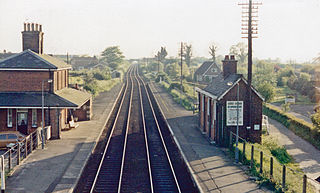
Oulton Broad South railway station is on the East Suffolk Line in the east of England, and is one of two stations serving Oulton Broad, Suffolk. The other is Oulton Broad North on the Wherry Lines. Oulton Broad South is the next station along from Lowestoft on the line to Ipswich, and from Lowestoft the line crosses Mutford Bridge with a view of Lake Lothing to the east and Oulton Broad Lake to the west. The station is 115 miles 42 chains (185.9 km) measured from London Liverpool Street via Ipswich.

Beccles railway station is on the East Suffolk Line in the east of England, serving the town of Beccles, Suffolk. It is 40 miles 34 chains (65.1 km) down the line from Ipswich and 109 miles 11 chains (175.6 km) measured from London Liverpool Street; it is situated between Brampton and Oulton Broad South stations. Its three-letter station code is BCC.

Derby Road railway station (also known as Derby Road (Ipswich)) is on the Felixstowe Branch Line in the east of England, serving the Rose Hill area and southern area of California on the eastern side of the town of Ipswich, Suffolk. It is 6 miles 8 chains (9.8 km) down the line from Ipswich station and 74 miles 67 chains (120.4 km) measured from London Liverpool Street; It is situated between Westerfield and Trimley and is managed by Greater Anglia, which also operates all passenger trains that call.

Westerfield railway station is on a branch line off the Great Eastern Main Line, in the East of England, serving the village of Westerfield, Suffolk. It is 3 miles 41 chains (5.7 km) from Ipswich and 72 miles 25 chains (116.4 km) from London Liverpool Street. It is situated at the junction of the Felixstowe Branch Line to Felixstowe, and the East Suffolk Line to Lowestoft. Its three-letter station code is WFI.

Ipswich railway station is on the Great Eastern Main Line in the East of England, serving the town of Ipswich, Suffolk. It is 68 miles 59 chains (110.6 km) down the line from London Liverpool Street and, on the main line, it is situated between Manningtree to the south and Needham Market to the north.

Saxmundham railway station is on the East Suffolk Line in the east of England, serving the town of Saxmundham, Suffolk. Situated between Wickham Market and Darsham, it is 22 miles 29 chains (36 km) down the line from Ipswich, and 91 miles 11 chains (147 km) from London Liverpool Street. Its three-letter station code is SAX.
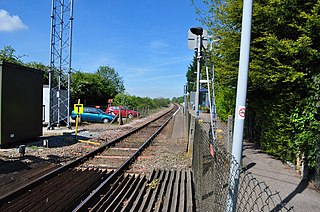
Brampton railway station is on the East Suffolk Line in the east of England, serving the villages of Brampton, Redisham and surrounding hamlets in Suffolk. It is 35 miles 70 chains (57.7 km) down the line from Ipswich and 104 miles 49 chains (168.4 km) measured from London Liverpool Street; it is situated between Halesworth and Beccles. It is commonly suffixed as Brampton (Suffolk) in order to distinguish it from the station of the same name in Cumbria.

Yarmouth South Town, sometimes known as Yarmouth Southtown, was a railway station in Great Yarmouth, Norfolk, England. It was one of three major stations in the town; the others being Yarmouth Vauxhall and Yarmouth Beach, of which only the former remains.

Aldeburgh railway station served the town of Aldeburgh, Suffolk, England. It was opened in 1860 by the East Suffolk Railway and later came under the control of the Great Eastern Railway. It was the terminus of an 8.5-mile branch line to Saxmundham and was closed in 1966 as part of the Beeching Axe.
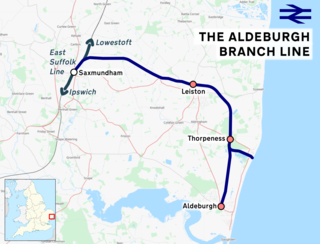
The Aldeburgh branch line was a railway branch line linking the town of Saxmundham on the East Suffolk line and the seaside resort of Aldeburgh. There were intermediate stops at Leiston and Thorpeness. Part of the line remains in use for nuclear flask trains servicing Sizewell nuclear power station.
The Yarmouth–Beccles line was a railway line which linked the Suffolk market town of Beccles with the Norfolk coastal resort of Yarmouth. Forming part of the East Suffolk Railway, the line was opened in 1859 and closed 100 years later in 1959.
The Framlingham branch was a six-mile (9.7 km) single-track branch railway line from Wickham Market railway station on the East Suffolk Line to Framlingham in Suffolk, England, with three intermediate stations, Parham, Hacheston Halt, and Marlesford.

The A1094 is an A road in the English county of Suffolk. It is around 7 miles (11 km) in length. The road runs from a junction off the A12 trunk road at Friday Street in Benhall to Aldeburgh on the North Sea coast. The road is single carriageway throughout.
The East Suffolk line is a railway in East Anglia with a long history.
